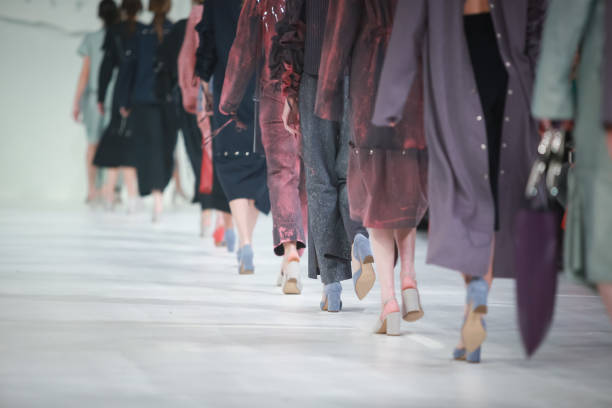Asian Cultural Appropriation in Fashion
Fashion at its core, is an evolving language of
self-expression. It thrives on creativity, innovation, and a rich tapestry of
inspirations from around the globe. Yet, as borders blur and fashion embraces a
global ethos, it's crucial to tread respectfully, particularly when drawing
inspiration from distinct cultures. One such recurring topic in the fashion
discourse is the cultural appropriation of Asian aesthetics. But how can
fashion houses and individuals draw from Asian cultures in a manner that's respectful
and authentic? Let's explore.

Understanding
Cultural Appropriation
Cultural appropriation refers to the adoption or imitation
of elements of one culture by members of another culture. When these elements
are taken out of their cultural context—often by a dominant culture—it can
perpetuate harmful stereotypes, and this can be deeply problematic.
For instance, the use of traditional Asian garments as mere
costumes, stripped of their cultural significance, or simplifying intricate
cultural symbols into mere fashion statements can be deemed insensitive.
Asian culture is vast and varied, spanning multiple
countries and civilizations that have rich histories spanning thousands of
years. Here is a brief overview:

Geographical Spread:
Asia, the largest continent, encompasses a wide variety of
ethnic groups, religions, traditions, and languages. From the Middle East to
the Far East, from Siberia to Indonesia, the continent's diverse cultures have
evolved based on geography, history, religion, and intercultural interactions.
Languages:
Asia is home to several language families, with each nation
often having its own language and several dialects. Major language families
include:
- Sino-Tibetan
(Chinese, Tibetan)
- Indo-European
(Hindi, Bengali, Persian, Punjabi)
- Altaic
(Turkish, Mongolian)
- Austroasiatic
(Khmer, Vietnamese)
- Dravidian
(Tamil, Telugu)
- Japonic
(Japanese)
- Koreanic
(Korean)
- Austronesian
(Malay, Tagalog, Javanese)
Religions:
Asia is the birthplace of many of the world's major
religions:
- Buddhism
- Hinduism
- Islam
- Christianity
- Sikhism
- Shintoism
- Taoism
- Confucianism
- Zoroastrianism
Festivals:
From the colorful Holi in Pakistan to the Lunar New Year
celebrated in various parts of East and Southeast Asia, to the traditional
Nowruz (Persian New Year) in Iran, festivals play an essential role in Asian
cultures.
Art & Architecture:
Asian art and architecture reflect the diversity of the
continent. From the intricate Arabesque art of the Islamic world, the vast
Great Wall of China, to the serene temples of Japan, Asian creativity spans
various forms and styles.
Literature:
Asian literature offers deep insights into the continent's
cultures. Notable works include the Indian epics Mahabharata and Ramayana,
China's "Journey to the West," Japan's "Tale of Genji," and
the Persian "Book of Kings" or Shahnameh.
Cuisine:
Asian cuisines are renowned for their flavors. While rice is
a staple in many Asian diets, the ways it's prepared and what it's served with
vary greatly. Think of sushi from Japan, biryani from India, or kimchi from
Korea.
Clothing:
Traditional attire in Asia reflects the region's diversity.
From the Indian sari and Japanese kimono to the Arabic thawb and the Korean
hanbok, each outfit tells a story of its people's history and values.
Philosophies and Values:
Many Asian cultures value concepts like harmony, respect for
elders, family centrality, and balance. Confucian teachings, for instance,
emphasize the importance of family and moral integrity.
Modern Developments:
Asia is not just about tradition. Countries like Japan,
South Korea, and China are at the forefront of technological advancements.
K-pop, anime, and Bollywood are significant cultural exports enjoyed globally.

A Return
to Natural Appreciation
Here are ways to ensure appreciation of Asian aesthetics in
fashion remains rooted in genuine respect:
- Education
First: Before adopting any element of Asian culture, one should invest
time in understanding its history, significance, and context. This ensures
an authentic representation and helps avoid trivialization.
- Collaboration:
Fashion designers can collaborate with artisans, experts, or designers
from the Asian community to ensure an authentic and respectful
representation. This not only provides credibility but also supports local
artisans and ensures a genuine blend of creativity.
- Ditch
Stereotypes: The Asian continent is vast, comprising multiple
countries with diverse cultures. Representing Asia with dragons, cherry
blossoms, or using the term "oriental" is a narrow and
stereotyped perspective. Fashion should celebrate the diverse aesthetics
of Asia, from the elegant Japanese kimonos to the rich Indian saris.
- Acknowledge,
Don't Erase: When drawing inspiration, always acknowledge the source.
It's essential to give credit where it's due and not present it as a novel
creation.
- Consumer
Responsibility: Consumers play a role too. By being informed, they can
make purchasing decisions that support authentic and respectful
representations of Asian culture. This also means calling out brands or
representations that may be inappropriate.
Inspiration,
Not Imitation
Drawing inspiration from Asian cultures isn't the issue;
it's the lack of understanding, the erasure of history, and the reduction of
rich traditions into fleeting trends that's problematic. By understanding and
valuing the depth of Asian cultures, fashion can be a platform for celebration,
not appropriation.
In conclusion, fashion's flirtation with global aesthetics
can be beautiful, but it requires a dance of respect, understanding, and
genuine appreciation. Only then can it transcend the boundaries of cloth and
stitch to weave stories that honor the rich tapestry of human culture.
Conclusion:
Asia's
vastness and diversity make it impossible to condense its cultures into a
single narrative. It's essential to approach this topic with an understanding
of its nuances and a willingness to delve deeper into each unique culture.
- Geographical
Diversity: Asia spans from the icy terrains of Siberia in Russia to
the tropical rainforests of Indonesia. This vastness brings a multitude of
climates, topographies, and natural resources that influence the
lifestyles, traditions, and economies of the people living in these
regions.
- Historical
Layers: The history of Asia is layered with ancient civilizations like
the Indus Valley, Mesopotamia, and Ancient China. Each has contributed
layers of cultural evolution, adding depth and complexity to the tapestry
of Asian culture.
- Inter-cultural
Interactions: Over millennia, Asia has seen numerous migrations,
invasions, trade relations, and diplomatic missions. The Silk Road, for
instance, was not just a trade route but a conduit of cultural exchange.
Such interactions have ensured that Asian cultures, while rooted in their
core philosophies, have absorbed and integrated elements from others.



Comments
Post a Comment